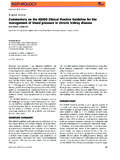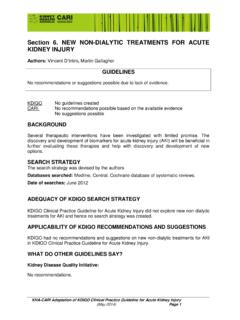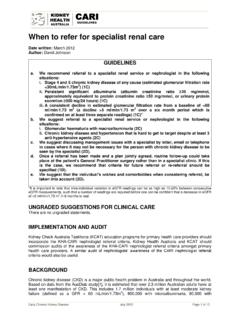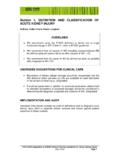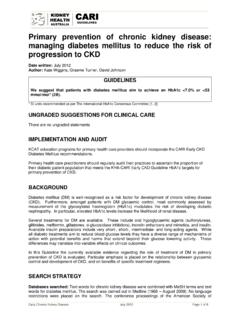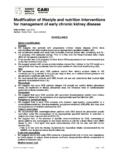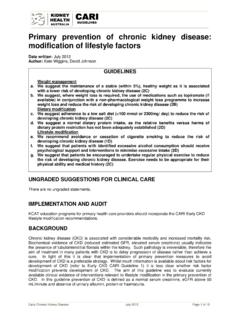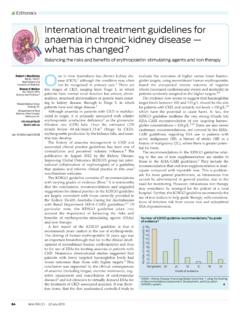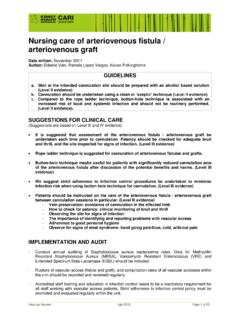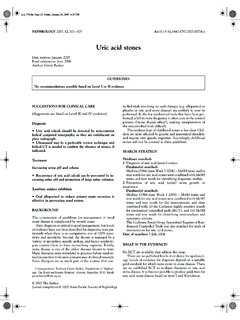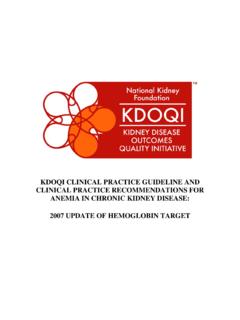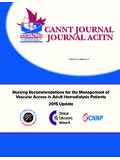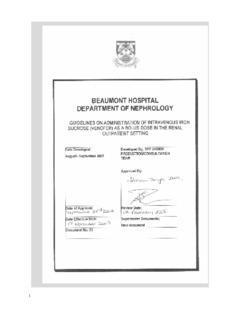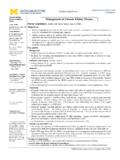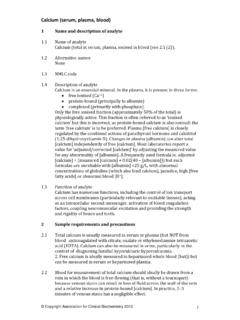Transcription of Diagnosis, classification and staging of chronic …
1 _____Early chronic kidney Disease July 2012 Page 1 of 31 Diagnosis, classification and staging of chronic kidney disease Date written: July 2012 Author: David Johnson GUIDELINES DIAGNOSIS a. We recommend that chronic kidney disease (CKD) be diagnosed in all individuals on at least 2 occasions for a period of at least 3 months, irrespective of the underlying cause and on the basis of: (1C) an estimated or measured glomerular filtration rate <60 mL/ m2 and/or evidence of kidney damage (albuminuria, proteinuria, haematuria after exclusion of urological causes, or structural abnormalities on kidney imaging tests) Note.
2 These diagnostic criteria are the same for all races and gender classification AND staging b. We recommend that the stages of CKD should be based on the combined indices of kidney function (measured or estimated GFR) and kidney damage (albuminuria/proteinuria), irrespective of the underlying diagnosis (1C). kidney function stage* GFR (mL/ m2) Description 1 90 Normal or increased GFR 2 60-89 Normal or slightly decreased GFR 3A 45-59 Mild-moderate decrease in GFR 3B 30-44 Moderate-severe decrease in GFR 4 15-29 Severe decrease in GFR 5 <15 or on dialysis End-stage kidney failure kidney damage stage* Urine albumin/ creatinine ratio (mg/mmol) 24h urine albumin (mg/day) Urine protein.
3 Creatinine ratio (mg/mmol) 24h urine protein (mg/day) Normoalbuminuria < (M) < (F) <30 <4 (M) <6 (F) <50 Microalbuminuria (M) (F) 30-300 4-40 (M) 6-60 (F) 50-500 Macroalbuminuria >25 (M) >35 (F) >300 >40 (M) >60 (F) >500 *When reporting kidney function, stage (stages 1-5) is combined with kidney damage (albuminuria/proteinuria (Norm/Micro/Macro-albuminuria)) and clinical diagnosis to fully specify CKD stage (eg Stage 2 CKD with microalbuminuria secondary to diabetic nephropathy).
4 Note: These staging criteria are the same for all races and gender. c. We recommend that these staging criteria be used to stratify CKD patient risk and be linked with specific management plans according to that level of risk (1C). _____Early chronic kidney Disease July 2012 Page 2 of 31 Albuminuria stage kidney function stage GFR (mL/ ) Normal (urine ACR mg/mmol) Male: < Female: < Microalbuminuria (urine ACR mg/mmol) Male: Female: Macroalbuminuria (urine ACR mg/mmol) Male: > 25 Female.
5 > 35 1 90 Not CKD unless haematuria, structural or pathological abnormalities present 2 60-89 3a 45-59 3b 30-44 4 15-29 5 <15 or on dialysis Risks of progressive CKD denoted as low (green), moderate (yellow), high (orange) and very high (red). [For specific management plans refer to chronic kidney Disease Management in General Practice [1]] Note: For patients with CKD, the combination of a low GFR and albuminuria or proteinuria places them at a greater risk of CKD progression at all ages, than those with just low GFR, albuminuria or proteinuria.
6 A measured or estimated GFR <45 mL/ is associated with increased risks of adverse renal, cardiovascular and other clinical outcomes, irrespective of age. d. We recommend that when CKD is initially diagnosed, to consider the underlying cause and to pursue the diagnosis sufficiently to exclude treatable pathology, such as obstruction, vasculitis, nephrotic syndrome and rapidly progressive glomerulonephritis (1C). e. We recommend an early repeat of the eGFR test if there is any suspicion of an acute condition.
7 It is particularly important to be sure that acute kidney disease is not missed by assuming the first abnormal eGFR represents a long-standing condition (1C). f. We recommend that the above criteria for CKD diagnosis and staging be applied irrespective of age (1C). UNGRADED SUGGESTIONS FOR CLINICAL CARE DIAGNOSIS i. The following diagnostic evaluation tests for CKD are always indicated: Full blood count Repeat (within 1 week) serum urea/electrolytes/creatinine/eGFR/albumi n Urine albumin: creatinine ratio (preferably on a first morning void, although a random urine is acceptable) Fasting lipids and glucose Urine microscopy and culture Renal ultrasound scan ii.
8 The following diagnostic evaluation tests for CKD are sometimes indicated: _____Early chronic kidney Disease July 2012 Page 3 of 31 If patient: Then carry out the following test: Has diabetes HbA1C Has eGFR < 60 mL/ Serum calcium, phosphate, PTH, 25-hydroxy-vitamin D and iron studies Is > 40 years old Serum and urine electrophoresis Has rash, arthritis or features of connective tissue disease Anti-nuclear antibodies, Extractable nuclear antigens, Complement studies Has pulmonary symptoms or deteriorating kidney function Anti-glomerular basement membrane antibody, Anti-neutrophil cytoplasmic antibody Has risk factors for HBV, HCV and HIV HBV, HCV.
9 HIV serology Has persistent albuminuria >60-120 mg/mmol (approximately equivalent to 24hr urinary protein >1-2 g/day) Refer to Nephrologist for consideration of renal biopsy IMPLEMENTATION AND AUDIT kidney Check Australia Taskforce (KCAT) education programs for primary health care providers should incorporate the CARI chronic kidney disease (CKD) classification system. KHA and KCAT should commission audits of the awareness of the CARI CKD classification amongst primary health care providers.
10 BACKGROUND chronic kidney disease is a major public health problem in Australia and throughout the world. Based on data from the AusDiab study [2], it is estimated that over million Australian adults have at least moderately severe kidney failure, defined as an estimated glomerular filtration rate (eGFR) less than 60 mL/ m2. This pernicious condition is often not associated with significant symptoms or urinary abnormalities and is unrecognized in 80-90% of cases [2-4]. CKD progresses at a rate that requires approximately 2300 individuals each year in Australia to commence either dialysis or kidney transplantation [5].
